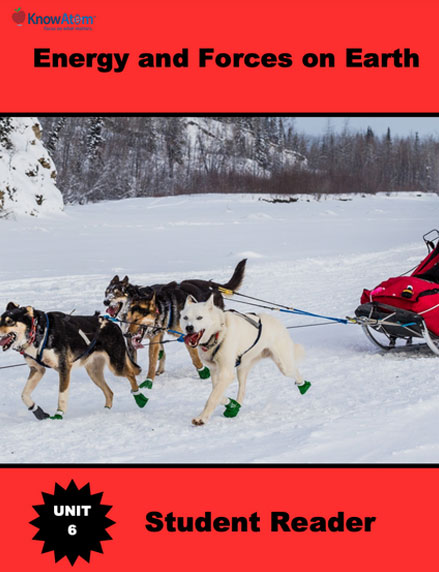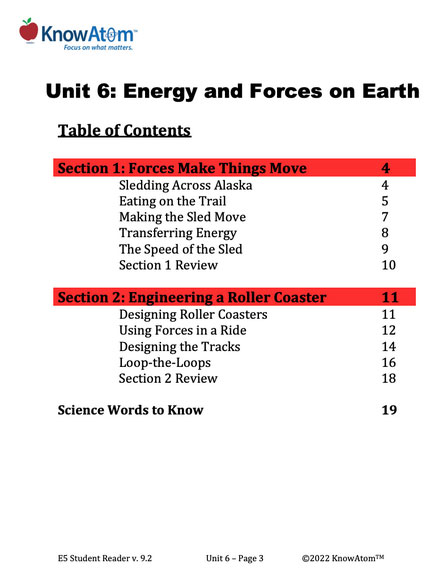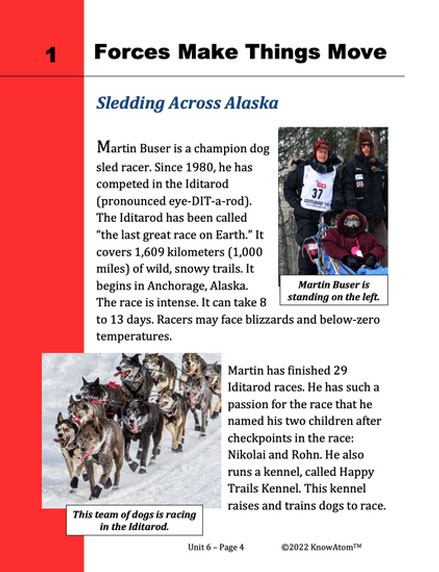Science background gives teachers more in-depth information about the phenomena students explore in this unit on energy and forces on Earth.
Martin Buser has such a passion for the Iditarod that he named his two children after checkpoints in the race—Nikolai and Rohn. He also runs a kennel, called Happy Trails Kennel, that raises and trains dogs to race.
Preparing for the Iditarod can take months, if not years. It is physically grueling for both the dogs and the musher, and those who make it to the end are usually exhausted and sleep- deprived. There are rules that have to be followed to make sure both the musher and the dogs are safe.
Once the race begins, the dogs need an almost-constant supply of energy. Energy is the ability to do work. Work is any change in position, speed, or state of matter due to force. Remember that consumers such as dogs get energy when they eat food. Racing dogs have a diet that often includes lamb, chicken, beef, moose, or salmon. They need between 10,000 and 12,000 calories a day to help pull the sled. Calories are the measure of energy that fuels your body.
Calories are a form of potential energy, which is energy that is stored. There are different forms of potential energy. For example, the energy in food is a form of potential energy called chemical energy, which is energy stored in the bonds of atoms and molecules. Because food is matter, it stores chemical energy.
Dogs can pull sleds because like all living things, their bodies turn the potential chemical energy stored in food into different forms of kinetic energy. Kinetic energy is the energy of motion.
We can understand how dogs use energy by thinking of them as energy systems. An energy system is a set of connected parts that change an input of energy to a different output of energy. When you eat, you are getting an input of energy in the form of calories (chemical energy). Your body stores some of that energy, and it turns the rest of it into different forms of kinetic energy. This is why it is important to eat enough calories. Without enough calories, you wouldn’t have enough energy for your heart to beat, your muscles to move, or your brain to regulate your body. These actions all require outputs of kinetic energy.
Not all energy systems are living things. For example, the dogs that pull the sled are part of another energy system that includes the dogs, the sled, and the musher.
Picture a dog sled. When the dogs are attached to the sled and they begin to run, they pull the sled. This input of energy is a pulling force that transfers the dogs’ kinetic energy to the sled. A force is a push or pull that acts on an object, changing its speed, direction, or shape. This transfer of energy causes the sled to move because it now also has kinetic energy. The movement of the sled is an output of energy.
This dog sled is an energy system, made up of the sled, the dogs, and the musher. Any time energy transforms (changes) from one form to another, it forms an energy system. For example, when you ride a bike, you and the bike form an energy system. You have potential energy in your body in the form of chemical energy stored in the bonds that hold food molecules together. When you move your legs, that chemical energy transforms into kinetic energy that powers your movement. The kinetic energy transfers to the bike, causing the bike’s wheels to turn.
Energy systems can also be human-made. Many of the technologies that power modern society are human-made energy systems that change one form of energy into different forms that do specific kinds of work. For example, an automobile is an energy system that takes chemical energy stored in a battery or fuel such as gasoline and changes it into kinetic energy that moves the car. As energy changes from one form to another, it is always conserved. This means that it is never created or destroyed. Because of this, sources of energy do not create energy. A source either stores energy or releases it in a way that can be changed to more useful forms. Fossil fuels store energy in their chemical bonds. A car engine burns gasoline, converting the fuel’s chemical energy into kinetic energy to make the car move. Wind turbines use the motion of the wind to turn turbines, which then produce electricity. Solar cells transfer light energy into electrical energy.
The conservation of energy means that in a perfect system, the total amount of energy will be conserved as it changes from one form to another. Let’s go back to the dog sled. The conservation of energy means that in a perfect system, however much kinetic energy the dogs transfer to the sled, the sled will have the same amount as it moves over the ground.
However, in the real world, some of that energy transfers out of the system. Friction is one way that energy is transferred out of a system. Friction is a force that slows motion whenever two objects rub against each other. Friction slows motion because it causes some of the energy of the moving object to change into heat. Friction is why your hands feel hot after you rub them together. It’s important to point out that energy isn’t disappearing as a result of friction. Instead, it’s transferring out of the system. Heat is evidence that energy has transferred out of the system and into the surrounding environment.








